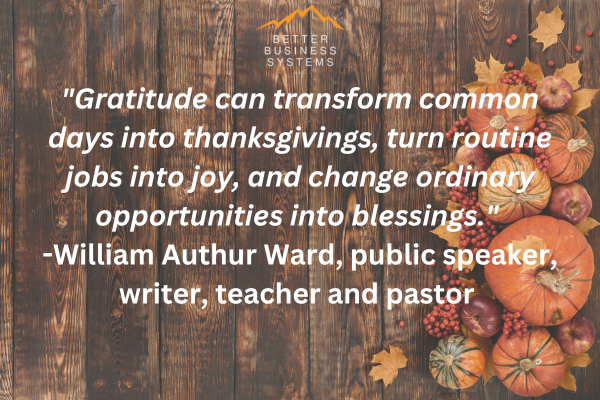While Thanksgiving gives us a day to count our blessings, much can be said for the benefits of cultivating an attitude of gratitude year-round.
Scientists have proven that people who are thankful experience improved health, more well-being, and a better ability to handle stress. Studies show that an attitude of gratitude improves sleep, reduces anxiety, and boosts the immune system.
The head doctor of biologic psychology at Duke University Medical Center stated, “If thankfulness was a drug, it would be the world’s best-selling product with a health benefit for every major organ system!”
Further, studies of the best teams, leaders, and cultures have shown a single constant among all the top performers – gratitude. These companies show that gratitude isn’t a “nice-to-have,” it’s an “absolute must-have!”
So if gratitude is that powerful, how do we build a culture of gratitude?
Research shows there are good business reasons to create a grateful workplace.
- A culture of gratitude is especially critical because it satisfies the higher psychological need to feel a sense of belonging to something greater than ourselves – giving a sense of meaning at work – where employees feel appreciated, valued, respected and empowered to reach their fullest potential.
- When employees feel valued, it inspires well-being, positivity and engagement – all of which directly influence job satisfaction, productivity, performance and retention. Employees are more motivated to do their best and work toward achieving the company’s goals. Dr. Robert Emmons, professor of psychology at the University of California characterizes gratitude “as the ultimate performance-enhancing drug!”
- Gratitude can create a ripple effect. When heartfelt gratitude is expressed, it transforms and inspires us – resulting in more collaboration, engagement and innovation across the organization.
- Thanking someone doesn’t have to be a huge, elaborate affair to make a big impact. By showing appreciation in a specific, personalized manner employees know their contributions matter.
- Findings from the Global Happiness Council’s 2019 Report show that employees who are recognized and appreciated often extend themselves to others, in kind of a pay-it-forward approach. The more they are recognized, the more they recognize and appreciate others in return, creating a virtuous circle of positivity and success.
- While we tend to focus on the receiver, it’s also important to acknowledge the benefits of gratitude for the giver – including increased connection, happiness, and well-being. This gives new meaning to the old adage, “It’s better to give than to receive.”
- On the flip side, research by the American Psychological Association shows that more than half of employees polled intended to search for new jobs because they felt underappreciated and undervalued.
In the spirit of the season, here are some tips to start creating a culture of gratitude at work.
- Say Thank You. The biggest takeaway from research on workplace gratitude is that employees need to hear “thank you” from colleagues, their employer, and their leader on a regular basis, year-round. Leaders can also say thanks in symbolic ways – by jumping in to help, lending a parking space, or giving a day off. Never underestimate the power of a simple thank you note or heartfelt email for work well done.
- Look Beyond Big Wins. Some employees’ contributions are impactful but less visible. Take the time to recognize their knowledge and expertise, their commitment to core values, or the effort they put in on a project.
- Forget the Gimmicks. When people feel supported and loved in the workplace, they don’t need gimmicks to enhance performance. Expressions of gratitude must be authentic, personal, and unrushed. There is nothing worse than fake gratitude. Teams spot that easily and it demotivates people every time. Gratitude should be a selfless act of giving to another – and doing so without any expectation in return is where the power lies.
- Build It In. Leaders can make gratitude a policy and practice through a wide variety of options, such as employee appreciation, recognition, or incentive programs. Gratitude can be built into performance reviews. In staff meetings, spending 5 minutes expressing gratitude can change team cohesion. There are literally hundreds of ways to reinforce a culture of gratitude from creating a “gratitude wall” for employees to recognize each other – to a “kudos” webpage that is accessible to all employees. Some organizations provide personalized gifts to employees or hold luncheons, after-work gatherings, and holiday parties. Others celebrate Employee Appreciation Day when everyone in the organization sends e-cards to colleagues. The list is endless.
- Provide Development Opportunities. According to Gallup, 70% of employees feel valued at work when they have opportunities for growth and development. In addition to formal training and certifications, there are many options that don’t cost money, such as new assignments, interesting projects, special task forces, and cross-training.
- Be Inclusive. Employees feel valued when they are included in decision-making and problem-solving for the greater good of the organization. The Entrepreneurial Operating System (EOS), with its shared Vision and weekly Level 10 Meetings, is a perfect example of how to incorporate regular feedback from employees – and then put it into action!
- Thank Customers. A culture of gratitude at the office naturally extends to your customers. Look for opportunities to say, “Thank you for putting your trust in us today.” “Thank you for giving us your business.” Or, thank them by providing sales, incentives, or coupons. Cultivating a culture of gratitude will boost your customer retention. A recent study shows that customers who were thanked increased their future purchases by 70%!
- Make it Timely. Gratitude is best shared when you think of it, or very soon after. It has a diminished rate of return with every day that goes by. Thank you’s should be specific and timely to be meaningful.
- Focus on Quality NOT Quantity. Too much gratitude can create “gratitude fatigue.” Forcing people to be grateful just doesn’t work. Expressions of gratitude must be authentic, sincere, and altruistically motivated.
- Walk the Talk. Last, gratitude must come from the top. Everyone knows as the leadership team goes, so does the rest of the organization! Leaders should model and normalize gratitude in their informal encounters with employees, as well as in more formal recruitment, onboarding, and performance review settings. The key to sustaining a culture of gratitude lies in embedding these practices in employees’ day-to-day routines.
While Thanksgiving is a great opportunity to acknowledge and remember the proven benefits of gratitude in the workplace, remember that the power of gratitude is too important to be celebrated on just one day. By creating a regular practice of lifting people up with recognition and appreciation, the entire workplace is elevated. You’ll keep your best people. You’ll attract great people – and they’ll be more productive. Simply put, it’s just a better way to live life.





